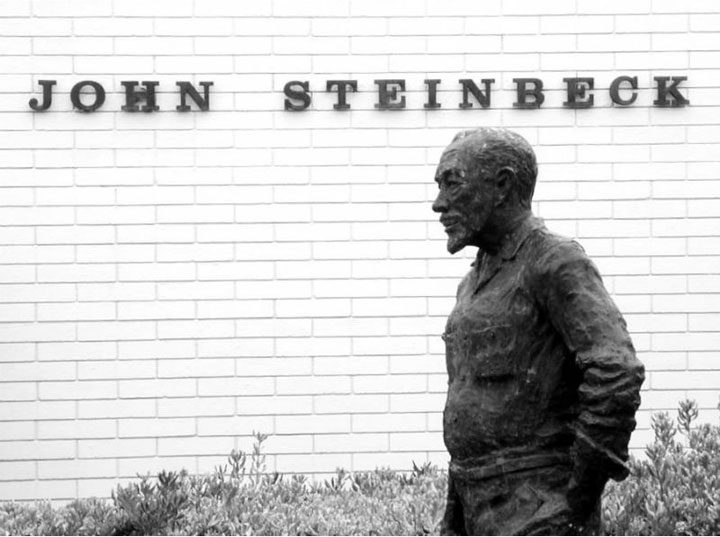 Salinas and Monterey—the two cities most closely associated with John Steinbeck and his California stories—both celebrate the life and work of the writer though a variety of public art projects. Although few of the murals and sculptures along Cannery Row in Monterey or in Steinbeck’s home town of Salinas approach the level of fine art, they enhance their surroundings while serving social, educational, and sponsorship interests in Steinbeck Country. When Steinbeck lovers visit, most view the works in a spirit of understanding.
Salinas and Monterey—the two cities most closely associated with John Steinbeck and his California stories—both celebrate the life and work of the writer though a variety of public art projects. Although few of the murals and sculptures along Cannery Row in Monterey or in Steinbeck’s home town of Salinas approach the level of fine art, they enhance their surroundings while serving social, educational, and sponsorship interests in Steinbeck Country. When Steinbeck lovers visit, most view the works in a spirit of understanding.
The tradition of spreading political and religious messages through large-scale mural paintings originated with the Olmec civilization, the first major civilization in Mexico, and continued through the Spanish Colonial period to the time of the Mexican Revolution and beyond. With a current Hispanic population approaching 75 per cent, it is not surprising that mural representations of Steinbeck and his works are found in the City of Salinas. Thanks to financial support from the Cannery Row Company, works of sculpture predominate in nearby Monterey. Best of all, new art inspired by Steinbeck continues to be produced.
John Steinbeck Murals in Downtown Salinas
Public agencies have played a role, funding the One Voice Murals Project to develop community pride and provide summer work experience for youth throughout Monterey County. Of more than a dozen large-scale murals from Castroville to Greenfield funded by the One Voice Project Arts & Leadership Project, four of the finished pieces—all in Salinas—portray Steinbeck-related themes.
With the help of eight young painters in 1998, supervising muralists Patrizia Johnson and Mel Mathewson created the mural that has become familiar to visitors to the National Steinbeck Center. Dominated by a portrait of the bearded writer, the work is comprised of a collage of images from books and movies including The Grapes of Wrath, Cannery Row, East of Eden, and The Red Pony. It greets passersby on a wall facing the entrance to the Center at 127 Main Street.
Two murals sponsored by One Voice were completed in 2001. Designed by Linda Galusha, the wall of the Salinas Valley Chamber of Commerce building at 119 East Alisal Street shows Steinbeck surrounded by dollar bills and important elements of commerce in the Salinas Valley, from an abacus to an ATM machine, as well as the transportation systems employed to move area agricultural products to world markets. Texas artist Christine Martin led the team that recreated mythical scenes from Steinbeck’s The Acts of King Arthur and His Noble Knights on the wall of the Grapes & Grains liquor store at 385 Salinas Street.
In 2002 a Macedonian-born artist named Blagojce Stojanovki supervised the completion of what is billed as the largest mural in California. Covering four huge wall panels of the Salinas Californian Newspaper Building at 123 West Alisal Street, the work depicts the writer with his books surrounded by images of scenes from his life.
The oldest Steinbeck-related art in Steinbeck’s home town is a bronze sculpture of the author (top of page) created in the early 1970s by Tom Fitzwater—a Greenfield native studying art at Cal State, Long Beach—and donated by the Soroptimist Club of Salinas. The larger-than-life statue stands at the entrance to the John Steinbeck Library at 350 Lincoln Avenue. The identity of the iconoclast who hack-sawed the cigarette from Steinbeck’s hand remains a mystery, along with his, her, or their motivation. Was it a do-gooder intent on protecting youth visiting the library from the evils of tobacco? A vandal bent on mindless destruction? Not all citizens appreciated the work when it was created. A photograph of Fitzwater in the collection of the Martha Heasley Cox Center for Steinbeck Studies at San Jose State University is captioned “the godawful bronze statue of Steinbeck that birds still gladly poop on today.”
John Steinbeck & Company in Public Art at Cannery Row
Through the Cannery Row Foundation, the Cannery Row Company—owner of real estate along the former ocean-front canning district featured in Steinbeck’s novel of the name—has supported much of the public art that graces this popular Monterey tourist destination, including bronze figures of several of Cannery Row’s most famous characters.
A bronze bust of the writer welcomes visitors to the Steinbeck Plaza at the foot of Prescott Avenue overlooking Monterey Bay. A plaque mounted on the base quotes the novel’s familiar opening paragraph: “Cannery Row in Monterey in California is a poem, a stink, a grating noise, a quality of light, a tone . . . .” The sculptor, Carol W. Brown, reported that, still embittered by her desertion and divorce, Steinbeck’s first wife—Carol Steinbeck Brown—delayed the work in progress with numerous requests that the artist portray her husband’s features unflatteringly. Some say she even claimed credit as co-creator of the work.
Three years after the publication of Cannery Row in 1945, Steinbeck’s close friend and collaborator—the pioneering marine biologist, ecologist, and philosopher Ed Ricketts—died following an automobile accident at a railroad crossing near Cannery Row. Local sculptor Jesse Corsaut created a bronze commemorative bust of Ricketts that is installed in a mini-park at Wave Street and Drake Avenue a few yards from the crossing site. Ricketts holds a star fish in his left hand and has had better luck than the bronze likeness of Steinbeck in Salinas. The star fish is frequently adorned with fresh flowers.
Ricketts and Steinbeck were accompanied on excursions to Mexico to collect marine specimens by the artist Bruce Ariss, a member of their charmed Cannery Row circle. The pencil sketches of his companions made by Ariss recently appeared on festive banners placed along the Row. The only public work by Ariss that survives—a panel illustrating the Lone Star Café and discarded boilers featured in Steinbeck’s novel—was salvaged from a larger temporary mural painted by later artists hired to block the view of the Clement Hotel when it was under construction. The Ariss mural stands at the foot of Bruce Ariss Way, opposite Ricketts’ lab, at 800 Cannery Row.
In 1957 the Latvian-born entrepreneur Kalisa Moore opened a restaurant in the former La Ida Café, another venue immortalized in Cannery Row. Catering to musicians, writers, and visitors in quest of the Row’s magic mixture of hardscrabble and bohemian lifestyles, she hosted an annual Steinbeck birthday celebration beginning in 1970. After she died in 2008 she was honored as the Queen of Cannery Row with a commemorative bronze bust by Jesse Corsaut. Appropriately, it is located next to the Bruce Aris mural.
Today three photo-realistic murals by Salinas artist John Cerney overlook the Monterey Bay Coastal Recreational Trail, built over the former route of the Southern Pacific Railroad. Each mural features a group of workers relaxing after a day laboring in the canneries, along with an extended caption taken from the text of Steinbeck’s novel. The painting of Mack and the Boys at the rear of 711 and 799 Cannery Row is based on a photograph of the original “boys” including Gabe Bicknell, the inspiration for Steinbeck’s character Mack in Cannery Row.
And the Art Goes On
Tributes to Steinbeck in art continue to attract area interest and support. For example, plans for a sculpture depicting the writer seated on a rock with imagined figures from local history were recently approved by the Monterey Architectural Review Committee. When completed, the work by Carmel sculptor Steven Whyte—“Monument to John Steinbeck and Cannery Row”—will be installed at Steinbeck Plaza, where it is certain to draw new attention to the life and work of Monterey County’s most famous son.
Photos by David A. Laws
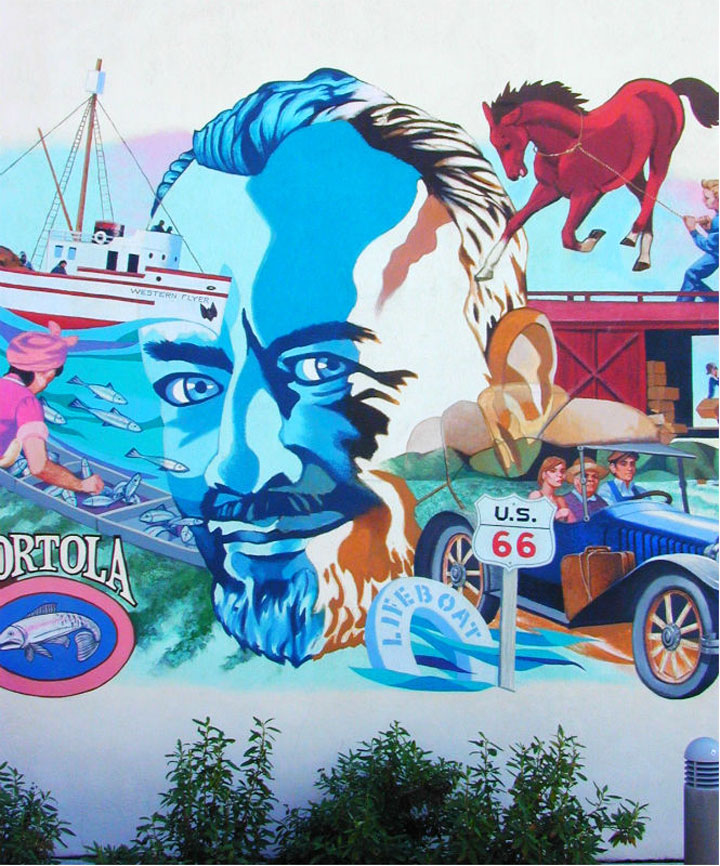
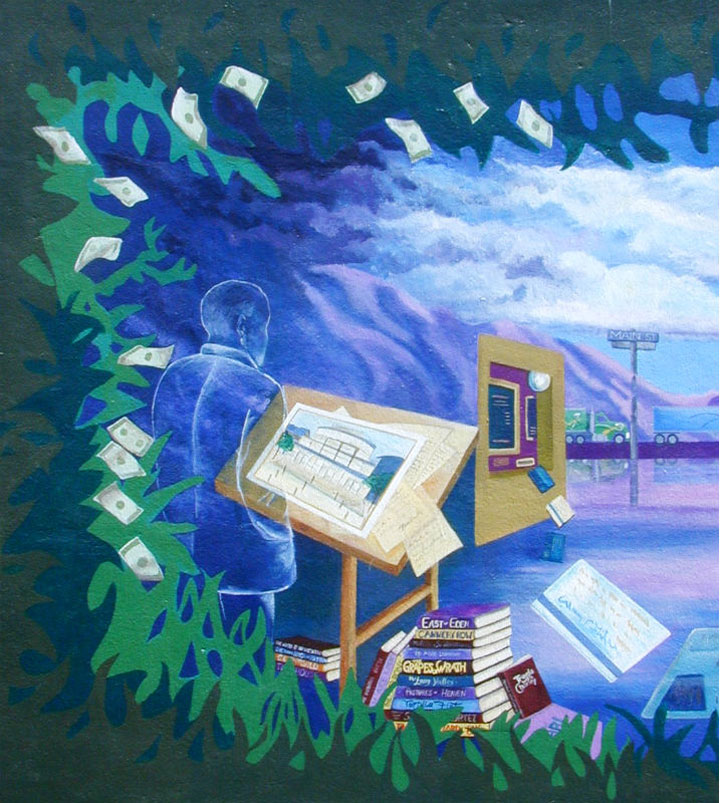
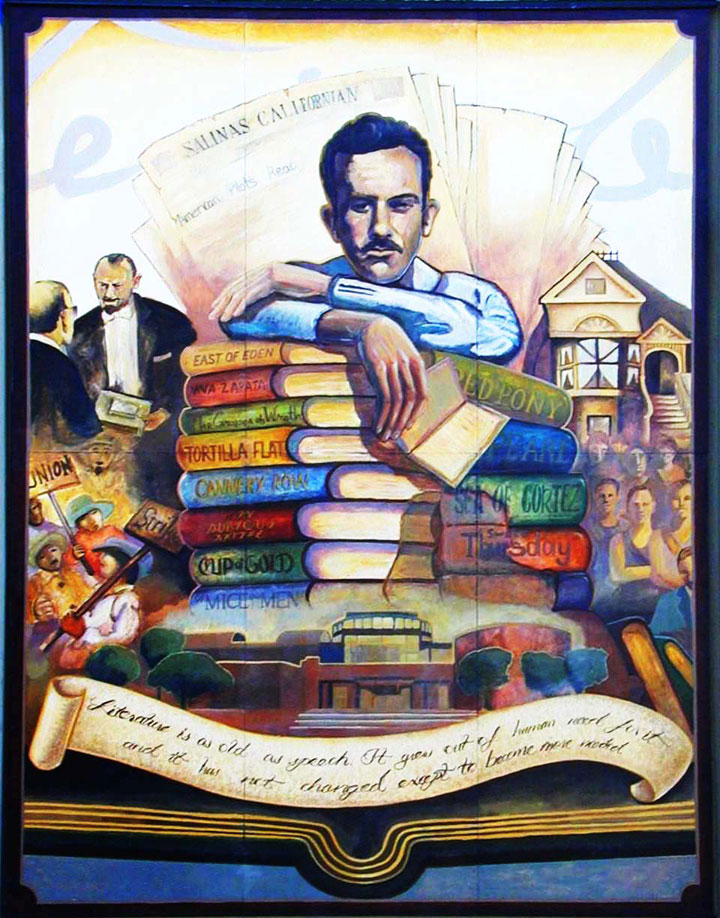
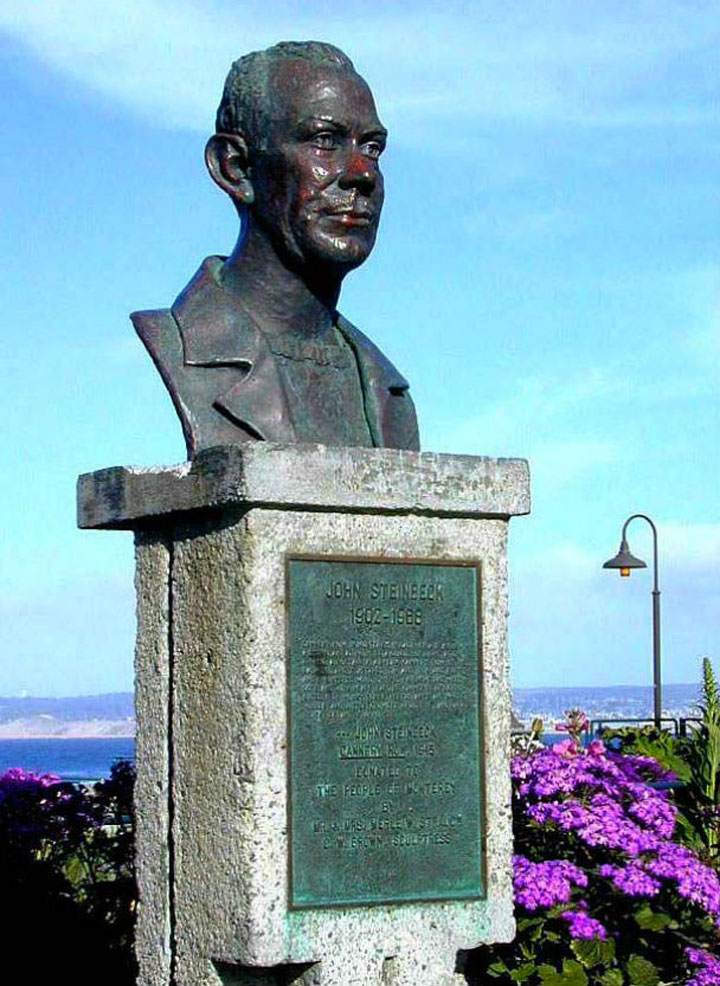
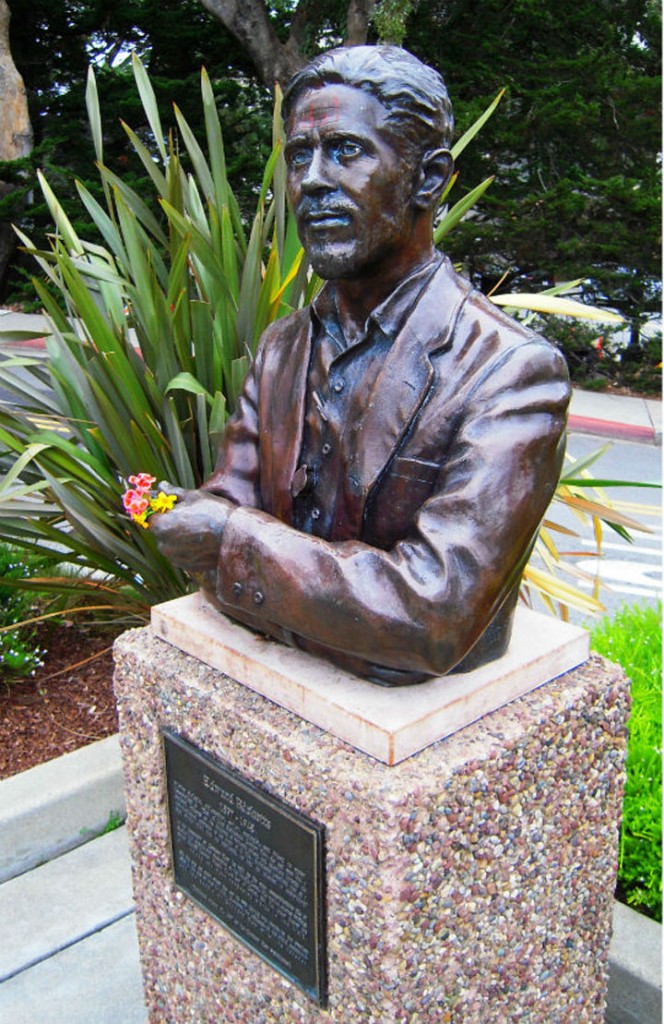
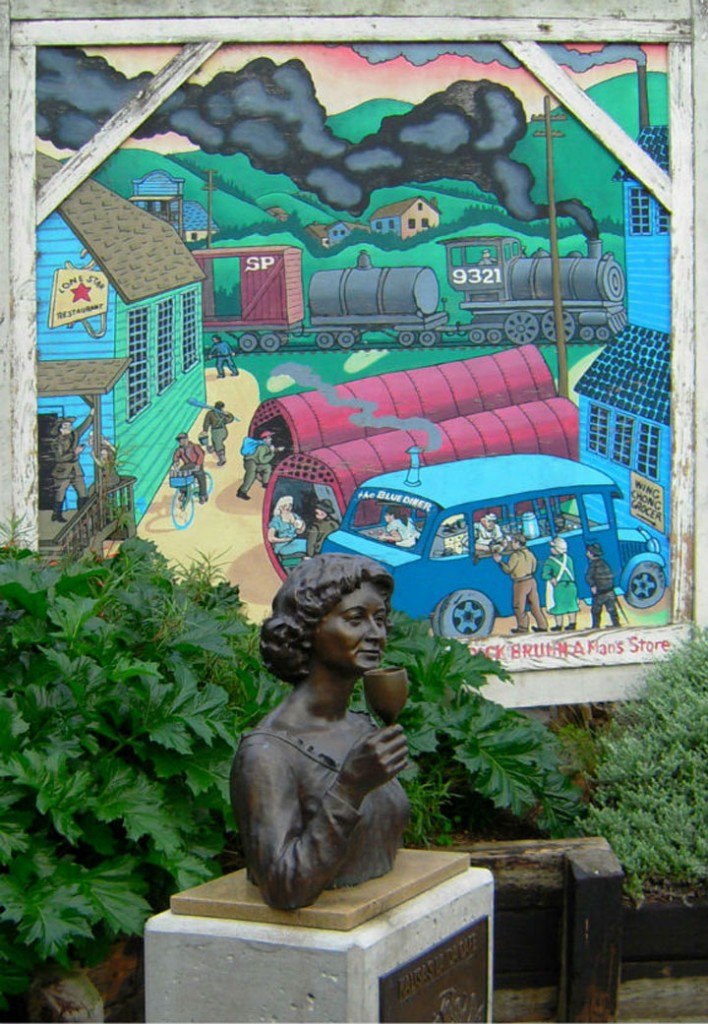
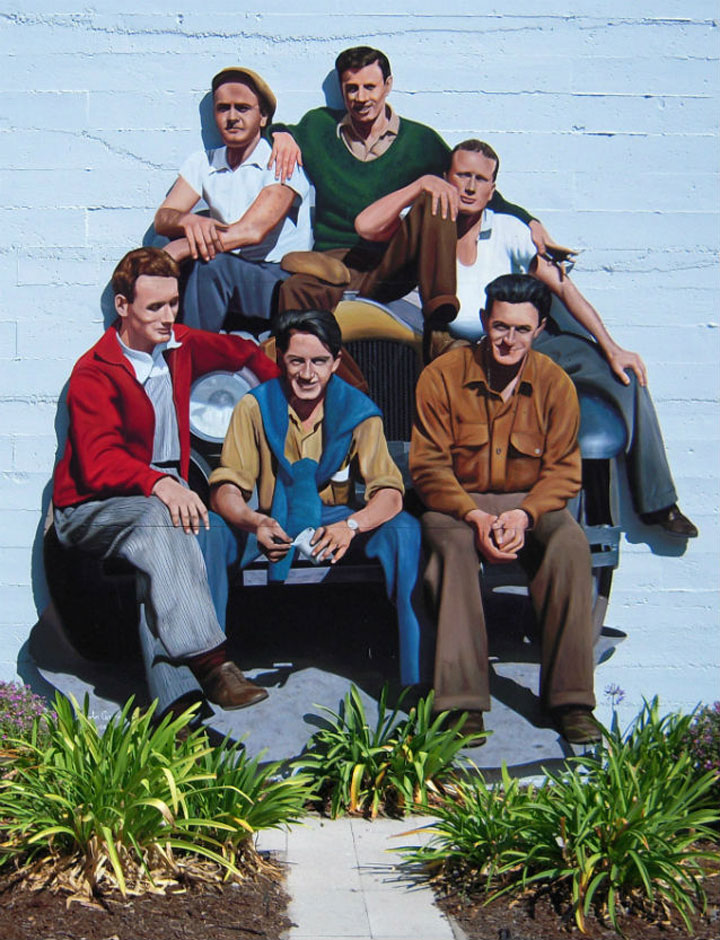


What a rich and gorgeous blog article!!! Do you mind if we link to it on our websites???
http://www.arts4mc.org and http://www.montereybay365.com
We’re an open community with a global network. It would be a pleasure and an honor to have you to join other organizations and sites in linking to us. Thank you!
This is the second bust of John Steinbeck placed at Steinbeck Plaza. In February 1973 the first bust, was donated to the city bv Mr. and Mrs. Strauch. Fanny Crow, John Steinbeck’s secretary helped with the accuracy. Sometime in October of 1991, this bust was stolen. Culprit unknown. By May 1993 a replacement was in place. cast from the original mold.